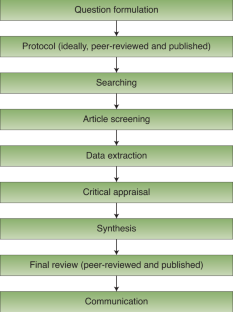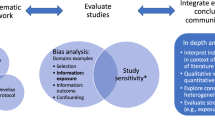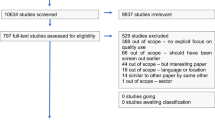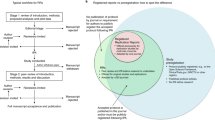Eight problems with literature reviews and how to fix them
Traditional approaches to reviewing literature may be susceptible to bias and result in incorrect decisions. This is of particular concern when reviews address policy- and practice-relevant questions. Systematic reviews have been introduced as a more rigorous approach to synthesizing evidence across studies; they rely on a suite of evidence-based methods aimed at maximizing rigour and minimizing susceptibility to bias. Despite the increasing popularity of systematic reviews in the environmental field, evidence synthesis methods continue to be poorly applied in practice, resulting in the publication of syntheses that are highly susceptible to bias. Recognizing the constraints that researchers can sometimes feel when attempting to plan, conduct and publish rigorous and comprehensive evidence syntheses, we aim here to identify major pitfalls in the conduct and reporting of systematic reviews, making use of recent examples from across the field. Adopting a ‘critical friend’ role in supporting would-be systematic reviews and avoiding individual responses to police use of the ‘systematic review’ label, we go on to identify methodological solutions to mitigate these pitfalls. We then highlight existing support available to avoid these issues and call on the entire community, including systematic review specialists, to work towards better evidence syntheses for better evidence and better decisions.
This is a preview of subscription content, access via your institution
Access options
Access Nature and 54 other Nature Portfolio journals
Get Nature+, our best-value online-access subscription
cancel any time
Subscribe to this journal
Receive 12 digital issues and online access to articles
133,45 € per year
only 11,12 € per issue
Buy this article
- Purchase on SpringerLink
- Instant access to full article PDF
Prices may be subject to local taxes which are calculated during checkout

Similar content being viewed by others

Challenges and recommendations on the conduct of systematic reviews of observational epidemiologic studies in environmental and occupational health
Article 15 May 2020

Insights from a cross-sector review on how to conceptualise the quality of use of research evidence
Article Open access 09 June 2021

The past, present and future of Registered Reports
Article 15 November 2021
Change history
References
- Grant, M. J. & Booth, A. A typology of reviews: an analysis of 14 review types and associated methodologies. Health Info Libr. J.26, 91–108 (2009). PubMedGoogle Scholar
- Haddaway, N. R. & Macura, B. The role of reporting standards in producing robust literature reviews. Nat. Clim. Change8, 444–447 (2018). Google Scholar
- Pullin, A. S. & Knight, T. M. Science informing policy–a health warning for the environment. Environ. Evid.1, 15 (2012). Google Scholar
- Haddaway, N., Woodcock, P., Macura, B. & Collins, A. Making literature reviews more reliable through application of lessons from systematic reviews. Conserv. Biol.29, 1596–1605 (2015). CASPubMedGoogle Scholar
- Pullin, A., Frampton, G., Livoreil, B. & Petrokofsky, G. Guidelines and Standards for Evidence Synthesis in Environmental Management (Collaboration for Environmental Evidence, 2018).
- White, H. The twenty-first century experimenting society: the four waves of the evidence revolution. Palgrave Commun.5, 47 (2019). Google Scholar
- O’Leary, B. C. et al. The reliability of evidence review methodology in environmental science and conservation. Environ. Sci. Policy64, 75–82 (2016). Google Scholar
- Woodcock, P., Pullin, A. S. & Kaiser, M. J. Evaluating and improving the reliability of evidence syntheses in conservation and environmental science: a methodology. Biol. Conserv.176, 54–62 (2014). Google Scholar
- Campbell Systematic Reviews: Policies and Guidelines (Campbell Collaboration, 2014).
- Higgins, J. P. et al. Cochrane Handbook for Systematic Reviews of Interventions (John Wiley & Sons, 2019).
- Shea, B. J. et al. AMSTAR 2: a critical appraisal tool for systematic reviews that include randomised or non-randomised studies of healthcare interventions, or both. BMJ358, j4008 (2017). PubMedPubMed CentralGoogle Scholar
- Haddaway, N. R., Land, M. & Macura, B. “A little learning is a dangerous thing”: a call for better understanding of the term ‘systematic review’. Environ. Int.99, 356–360 (2017). PubMedGoogle Scholar
- Freeman, R. E. Strategic Management: A Stakeholder Approach (Cambridge Univ. Press, 2010).
- Haddaway, N. R. et al. A framework for stakeholder engagement during systematic reviews and maps in environmental management. Environ. Evid.6, 11 (2017). Google Scholar
- Land, M., Macura, B., Bernes, C. & Johansson, S. A five-step approach for stakeholder engagement in prioritisation and planning of environmental evidence syntheses. Environ. Evid.6, 25 (2017). Google Scholar
- Oliver, S. & Dickson, K. Policy-relevant systematic reviews to strengthen health systems: models and mechanisms to support their production. Evid. Policy12, 235–259 (2016). Google Scholar
- Savilaakso, S. et al. Systematic review of effects on biodiversity from oil palm production. Environ. Evid.3, 4 (2014). Google Scholar
- Savilaakso, S., Laumonier, Y., Guariguata, M. R. & Nasi, R. Does production of oil palm, soybean, or jatropha change biodiversity and ecosystem functions in tropical forests. Environ. Evid.2, 17 (2013). Google Scholar
- Haddaway, N. R. & Crowe, S. Experiences and lessons in stakeholder engagement in environmental evidence synthesis: a truly special series. Environ. Evid.7, 11 (2018). Google Scholar
- Sánchez-Bayo, F. & Wyckhuys, K. A. Worldwide decline of the entomofauna: a review of its drivers. Biol. Conserv.232, 8–27 (2019). Google Scholar
- Agarwala, M. & Ginsberg, J. R. Untangling outcomes of de jure and de facto community-based management of natural resources. Conserv. Biol.31, 1232–1246 (2017). PubMedGoogle Scholar
- Gurevitch, J., Curtis, P. S. & Jones, M. H. Meta-analysis in ecology. Adv. Ecol. Res.32, 199–247 (2001). CASGoogle Scholar
- Haddaway, N. R., Macura, B., Whaley, P. & Pullin, A. S. ROSES RepOrting standards for Systematic Evidence Syntheses: pro forma, flow-diagram and descriptive summary of the plan and conduct of environmental systematic reviews and systematic maps. Environ. Evid.7, 7 (2018). Google Scholar
- Lwasa, S. et al. A meta-analysis of urban and peri-urban agriculture and forestry in mediating climate change. Curr. Opin. Environ. Sustain.13, 68–73 (2015). Google Scholar
- Pacifici, M. et al. Species’ traits influenced their response to recent climate change. Nat. Clim. Change7, 205–208 (2017). Google Scholar
- Owen-Smith, N. Ramifying effects of the risk of predation on African multi-predator, multi-prey large-mammal assemblages and the conservation implications. Biol. Conserv.232, 51–58 (2019). Google Scholar
- Prugh, L. R. et al. Designing studies of predation risk for improved inference in carnivore-ungulate systems. Biol. Conserv.232, 194–207 (2019). Google Scholar
- Li, Y. et al. Effects of biochar application in forest ecosystems on soil properties and greenhouse gas emissions: a review. J. Soil Sediment.18, 546–563 (2018). CASGoogle Scholar
- Moher, D., Liberati, A., Tetzlaff, J. & Altman, D. G., The PRISMA Group. Preferred reporting items for systematic reviews and meta-analyses: the PRISMA statement. PLoS Med.6, e1000097 (2009). PubMedPubMed CentralGoogle Scholar
- Bernes, C. et al. What is the influence of a reduction of planktivorous and benthivorous fish on water quality in temperate eutrophic lakes? A systematic review. Environ. Evid.4, 7 (2015). Google Scholar
- McDonagh, M., Peterson, K., Raina, P., Chang, S. & Shekelle, P. Avoiding bias in selecting studies. Methods Guide for Effectiveness and Comparative Effectiveness Reviews [Internet] (Agency for Healthcare Research and Quality, 2013).
- Burivalova, Z., Hua, F., Koh, L. P., Garcia, C. & Putz, F. A critical comparison of conventional, certified, and community management of tropical forests for timber in terms of environmental, economic, and social variables. Conserv. Lett.10, 4–14 (2017). Google Scholar
- Min-Venditti, A. A., Moore, G. W. & Fleischman, F. What policies improve forest cover? A systematic review of research from Mesoamerica. Glob. Environ. Change47, 21–27 (2017). Google Scholar
- Bramer, W. M., Giustini, D. & Kramer, B. M. R. Comparing the coverage, recall, and precision of searches for 120 systematic reviews in Embase, MEDLINE, and Google Scholar: a prospective study. Syst. Rev.5, 39 (2016). PubMedPubMed CentralGoogle Scholar
- Bramer, W. M., Giustini, D., Kramer, B. M. R. & Anderson, P. F. The comparative recall of Google Scholar versus PubMed in identical searches for biomedical systematic reviews: a review of searches used in systematic reviews. Syst. Rev.2, 115 (2013). PubMedPubMed CentralGoogle Scholar
- Gusenbauer, M. & Haddaway, N. R. Which academic search systems are suitable for systematic reviews or meta‐analyses? Evaluating retrieval qualities of Google Scholar, PubMed, and 26 other resources. Res. Synth. Methods11, 181–217 (2020). PubMedPubMed CentralGoogle Scholar
- Livoreil, B. et al. Systematic searching for environmental evidence using multiple tools and sources. Environ. Evid.6, 23 (2017). Google Scholar
- Mlinarić, A., Horvat, M. & Šupak Smolčić, V. Dealing with the positive publication bias: why you should really publish your negative results. Biochem. Med.27, 447–452 (2017). Google Scholar
- Lin, L. & Chu, H. Quantifying publication bias in meta‐analysis. Biometrics74, 785–794 (2018). PubMedGoogle Scholar
- Haddaway, N. R. & Bayliss, H. R. Shades of grey: two forms of grey literature important for reviews in conservation. Biol. Conserv.191, 827–829 (2015). Google Scholar
- Viechtbauer, W. Conducting meta-analyses in R with the metafor package. J. Stat. Softw.36, 1–48 (2010). Google Scholar
- Bilotta, G. S., Milner, A. M. & Boyd, I. On the use of systematic reviews to inform environmental policies. Environ. Sci. Policy42, 67–77 (2014). Google Scholar
- Englund, G., Sarnelle, O. & Cooper, S. D. The importance of data‐selection criteria: meta‐analyses of stream predation experiments. Ecology80, 1132–1141 (1999). Google Scholar
- Burivalova, Z., Şekercioğlu, Ç. H. & Koh, L. P. Thresholds of logging intensity to maintain tropical forest biodiversity. Curr. Biol.24, 1893–1898 (2014). CASPubMedGoogle Scholar
- Bicknell, J. E., Struebig, M. J., Edwards, D. P. & Davies, Z. G. Improved timber harvest techniques maintain biodiversity in tropical forests. Curr. Biol.24, R1119–R1120 (2014). CASPubMedGoogle Scholar
- Damette, O. & Delacote, P. Unsustainable timber harvesting, deforestation and the role of certification. Ecol. Econ.70, 1211–1219 (2011). Google Scholar
- Blomley, T. et al. Seeing the wood for the trees: an assessment of the impact of participatory forest management on forest condition in Tanzania. Oryx42, 380–391 (2008). Google Scholar
- Haddaway, N. R. et al. How does tillage intensity affect soil organic carbon? A systematic review. Environ. Evid.6, 30 (2017). Google Scholar
- Higgins, J. P. et al. The Cochrane Collaboration’s tool for assessing risk of bias in randomised trials. BMJ343, d5928 (2011). PubMedPubMed CentralGoogle Scholar
- Stewart, G. Meta-analysis in applied ecology. Biol. Lett.6, 78–81 (2010). PubMedGoogle Scholar
- Koricheva, J. & Gurevitch, J. Uses and misuses of meta‐analysis in plant ecology. J. Ecol.102, 828–844 (2014). Google Scholar
- Vetter, D., Ruecker, G. & Storch, I. Meta‐analysis: a need for well‐defined usage in ecology and conservation biology. Ecosphere4, 1–24 (2013). Google Scholar
- Stewart, G. B. & Schmid, C. H. Lessons from meta-analysis in ecology and evolution: the need for trans-disciplinary evidence synthesis methodologies. Res. Synth. Methods6, 109–110 (2015). PubMedGoogle Scholar
- Macura, B. et al. Systematic reviews of qualitative evidence for environmental policy and management: an overview of different methodological options. Environ. Evid.8, 24 (2019). Google Scholar
- Koricheva, J. & Gurevitch, J. in Handbook of Meta-analysis in Ecology and Evolution (eds Koricheva, J. et al.) Ch. 1 (Princeton Scholarship Online, 2013).
- Britt, M., Haworth, S. E., Johnson, J. B., Martchenko, D. & Shafer, A. B. The importance of non-academic coauthors in bridging the conservation genetics gap. Biol. Conserv.218, 118–123 (2018). Google Scholar
- Graham, L., Gaulton, R., Gerard, F. & Staley, J. T. The influence of hedgerow structural condition on wildlife habitat provision in farmed landscapes. Biol. Conserv.220, 122–131 (2018). Google Scholar
- Delaquis, E., de Haan, S. & Wyckhuys, K. A. On-farm diversity offsets environmental pressures in tropical agro-ecosystems: a synthetic review for cassava-based systems. Agric. Ecosyst. Environ.251, 226–235 (2018). Google Scholar
- Popay, J. et al. Guidance on the Conduct of Narrative Synthesis in Systematic Reviews: A Product from the ESRC Methods Programme Version 1 (Lancaster Univ., 2006).
- Pullin, A. S. et al. Human well-being impacts of terrestrial protected areas. Environ. Evid.2, 19 (2013). Google Scholar
- Waffenschmidt, S., Knelangen, M., Sieben, W., Bühn, S. & Pieper, D. Single screening versus conventional double screening for study selection in systematic reviews: a methodological systematic review. BMC Med. Res. Methodol.19, 132 (2019). PubMedPubMed CentralGoogle Scholar
- Rallo, A. & García-Arberas, L. Differences in abiotic water conditions between fluvial reaches and crayfish fauna in some northern rivers of the Iberian Peninsula. Aquat. Living Resour.15, 119–128 (2002). Google Scholar
- Glasziou, P. & Chalmers, I. Research waste is still a scandal—an essay by Paul Glasziou and Iain Chalmers. BMJ363, k4645 (2018). Google Scholar
- Haddaway, N. R. Open Synthesis: on the need for evidence synthesis to embrace Open Science. Environ. Evid.7, 26 (2018). Google Scholar
Acknowledgements
We thank C. Shortall from Rothamstead Research for useful discussions on the topic.
Author information
Authors and Affiliations
- Mercator Research Institute on Climate Change and Global Commons, Berlin, Germany Neal R. Haddaway
- Stockholm Environment Institute, Stockholm, Sweden Neal R. Haddaway & Biljana Macura
- Africa Centre for Evidence, University of Johannesburg, Johannesburg, South Africa Neal R. Haddaway
- College of Medicine and Health, Exeter University, Exeter, UK Alison Bethel
- Department of Zoology, University of Cambridge, Cambridge, UK Lynn V. Dicks
- School of Biological Sciences, University of East Anglia, Norwich, UK Lynn V. Dicks
- Department of Biological Sciences, Royal Holloway University of London, Egham, UK Julia Koricheva
- Department of Zoology, University of Oxford, Oxford, UK Gillian Petrokofsky
- Collaboration for Environmental Evidence, UK Centre, School of Natural Sciences, Bangor University, Bangor, UK Andrew S. Pullin
- Liljus ltd, London, UK Sini Savilaakso
- Department of Forest Sciences, University of Helsinki, Helsinki, Finland Sini Savilaakso
- Evidence Synthesis Lab, School of Natural and Environmental Sciences, University of Newcastle, Newcastle-upon-Tyne, UK Gavin B. Stewart
- Neal R. Haddaway





